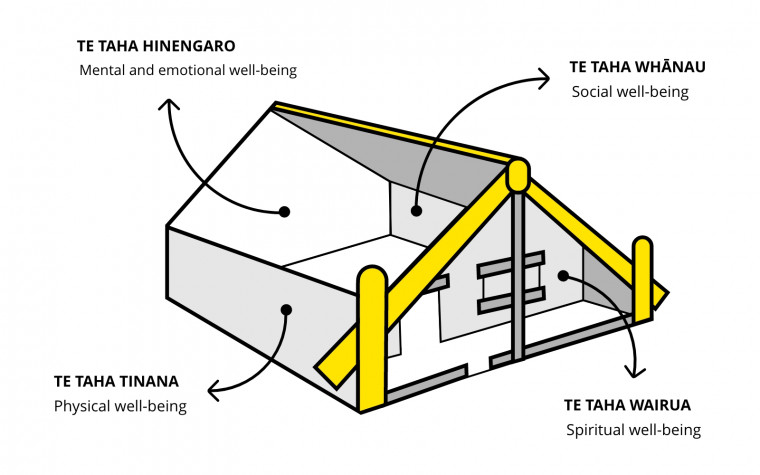About your health
Mō tō hauora
Te Whare Tapa Whā

The Te Whare Tapa Whā model of health, initially proposed in 1984 by Sir Mason Durie a prominent Māori psychiatrist, suggests that a person's wellbeing is a function of their wellbeing across four areas of their life, all of which are connected, like the walls of a Whārenui (meeting house). The Whārenui's connection with the whenua (land) forms the foundation.
The model reinforces the importance of nurturing all four dimensions of our hauora (health) for overall wellbeing. All four walls are interconnected and work harmoniously together to support holistic wellness. Each of the walls are dependent on the others standing strong to maintain a solid whare.
- taha tinana (physical wellbeing) Is about how our body grows, feels and moves, how we care for it, and what we put into it. Nourishing and strengthening our physical wellbeing enables us to cope with the ups and downs of life. Changes in our physical health can have a direct impact on other aspects of our health, such as our mental and emotional health. Some key behaviours related to taha tinana are physical activity, healthy eating, sleep and smoking.
- taha hinengaro (mental wellbeing) Taha hinengaro is a person’s thoughts, feelings, mind, conscience, and heart. It’s about how we feel, as well as how we communicate and think. Taking care of taha hinengaro is important for everyone, regardless of whether or not we’ve experienced mental illness or distress. When taha hinengaro is strong, people are able to gain perspective on their thoughts and feelings, remain hopeful in the face of distress, and make choices that reflect what matters to them. Behaviours relevant to taha hinengaro include being able to express our thoughts and feelings, making choices that reflect a balance of short and long term interests, allowing distressing thoughts and feelings without being overwhelmed by them, and being able to notice when stress is becoming unhelpful and taking effective action to manage it.
- taha wairua (spiritual wellbeing). Our spiritual essence is our life force, or mauri. This is the essence of who and what matters to you. Different people have different perspectives of wairua. For some, wairua is linked to religion or faith, and for others it is about a connection to something divine in each of us. For others, it encompasses the values, ethical & moral standards and the passions that drive the things in life that matter to each of us. It also links to identity, such as one’s cultural identity or one’s professional identity, including our identity as a member of the NZDF, service, trade and unit. Behaviours that relate to taha wairua are things like going to church, being passionate about one’s work, acting according to the principles that are important to us, and maintaining a connection to family and the place we came from.
- taha whānau (family or social wellbeing). Taha whānau is about where and who we feel we belong, who matters to us in our life, who we spend our time with, and who we choose to love. Whānau is not just our immediate family, and includes the networks, extended relationships, and groups we belong to, as well as our friends, hoamahi (colleagues), and community. Everyone has a place and a role to fulfil within their whānau, and whānau contributes to our individual wellbeing and identity. Connection and belonging are fundamental to human wellbeing. Behaviours that relate to taha whānau include how openly we engage in relationships with friends and family, being connected to our work colleagues and how we show up in our romantic relationships.
Your Health is divided into four sections spanning the four domains of our hauora. Additionally ,a section on Health at Work is included to encompass some of the environmental factors impacting hauora. A range of tips and self-management tools are provided, and at the end of each section you can find a list of additional links for more information and support.